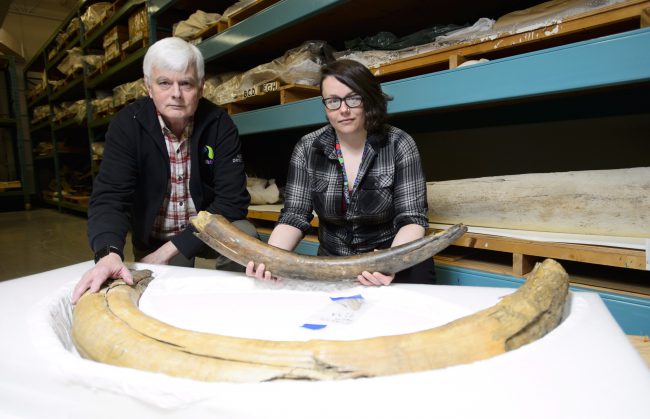OTTAWA – It was a late July afternoon when Kieran Shepherd got a call from the Canadian embassy in Washington with a message: The FBI had something pretty old that they wanted to give him.

What they wanted to give Shepherd, curator of paleobiology at the Canadian Museum of Nature, were a pair of mammoth tusks taken from Canada more than 50 years ago.
Their path home is the most unusual Shepherd has seen in his 30 years at the national museum and involves a massive FBI investigation, an infamous American collector, the RCMP and diplomats on both sides of the border.
“Most of the material we have our scientists have collected, so it’s pretty rare to have a repatriation,” Shepherd said Thursday at the museum’s fossil collections centre in Gatineau, Que.
The story – which is not yet over – reads like a detective novel, he said.
READ MORE: Archaeologists are preserving a 14,000-year-old mammoth found in Mexico
The FBI recovered the tusks from the Indiana home of Don Miller, who had them as part a massive collection that included Indigenous arrowheads, fossils, shrunken skulls and a chunk of concrete he claimed was from the bunker where Adolf Hitler died at the end of the Second World War, among other items from countries such as China, Russia, Greece, Italy and Papua New Guinea.
- Most Canadians want their cars made domestically, KPMG survey shows
- RCMP union cuts into Alberta Next Panel for ‘politically driven’ recommendation to shed Mounties
- What’s ahead for Lululemon in 2026 amid stock, CEO and investor questions?
- Vancouver Whitecaps to settle fan lawsuit claiming Messi no-show
There was also some of his own memorabilia, including items from the day he was apparently involved in testing the first atom bomb in 1945. His involvement in the Manhattan Project was the focus of a four-part series in his local newspaper in 2007.

Get breaking National news
He regularly gave local children a look through his personal museum and the collection he had amassed through trips that crossed the globe.
Miller was 91 when the FBI raided his home in 2014 alleging that he had improperly collected the artifacts. Miller co-operated with investigators and no charges were ever laid. An FBI spokeswoman said the investigation remains open.
Miller told investigators before his death in 2015 that he brought the tusks home from a trip between Calgary and the Yukon-Alaska border in 1960 and believed they were from a mastodon, which would make them a rare find.
READ MORE: Canadian rocks found to contain oldest known evidence of life on Earth
At the time of Miller’s trip, he could have easily left Canada with the tusks strapped to the hood of his car without being stopped at the border.
Federal and provincial laws were enacted in the 1990s to restrict the movement of artifacts across provincial and national borders, including mammoth tusks that are increasingly used to create ivory carvings for trade around the world, said Gerald Oetelaar, a professor of archeology and anthropology at the University of Calgary.
After years of work, the FBI and the U.S. State Department began making phone calls in July to figure out how to return the tusks, which are likely between 12,000 and 20,000 years old.
“Paleontological material is an important link to Canada’s cultural heritage, and we are glad to see these specimens have been returned to their rightful country of origin,” Kelly Craft, the U.S. ambassador to Canada, said in a statement.
READ MORE: B.C. once home to ancient hedgehogs, tapirs
In October, American officials packed up the tusks and shipped them across the country to the Canadian embassy in Washington. Just before the holidays in December, the tusks arrived in Ottawa.
“I was actually kind of surprised. They were in very good shape,” Shepherd said. “Sometimes collectors don’t have the expertise to look after fossils and these were well cared for.”
Next, researchers took a run-of-the-mill table saw and sliced a open a piece of the tusk that showed a pattern inside revealing them to be from the much larger mammoth, which were more regularly found in Canada.
Oetelaar, who is not involved in the museum’s work, said well-preserved tusks are generally found in colder climates like in the North.
The museum plans to run chemical tests on the tusks to determine if they are from Alberta or Yukon and get a better idea of mammoth biology before they are displayed publicly later this year, said Danielle Fraser, the museum’s paleobiologist and fossil mammal expert.
“The story has not ended,” Fraser said.







Comments